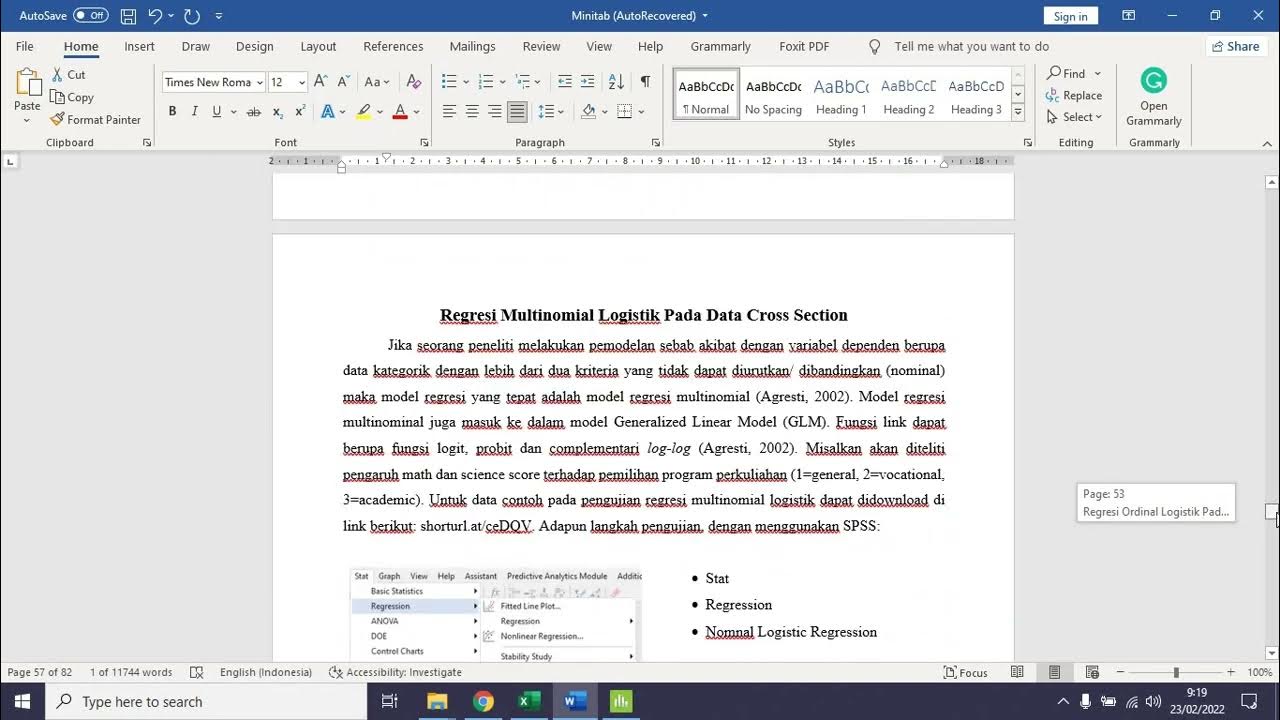REGRESI DENGAN DUMMY VARIABEL DUA KATEGORI Oleh Agus Tri Basuki Part 1
Summary
TLDRThis video provides a detailed explanation of using dummy variables in regression analysis. The speaker introduces the concept of dummy variables as categorical representations in regression models, explaining their application in different regression types like ANOVA and ANCOVA. Through a case study involving consumption and GDP before and after regional autonomy, the speaker demonstrates how dummy variables impact regression models and the interpretation of data. The video emphasizes the importance of statistical significance and model selection for accurate predictions and real-world insights into economic changes.
Takeaways
- 😀 Dummy variables are used in regression models to handle qualitative (categorical) data, turning it into numerical form.
- 😀 There are three main types of regression models: quantitative dependent variables with qualitative independent variables, quantitative and qualitative independent variables, and linear probability models.
- 😀 Dummy variables represent categories with values like 0 or 1, such as 'before' and 'after' a specific event, or male and female.
- 😀 Regression with dummy variables can be approached using ANOVA (Analysis of Variance) when only qualitative data is involved.
- 😀 ANCOVA (Analysis of Covariance) is used when both qualitative and quantitative independent variables are included in the regression model.
- 😀 The regression model helps in understanding the effects of different factors, such as the impact of regional autonomy on household consumption.
- 😀 In practical examples, the speaker uses household consumption and regional economic factors like PDB (Gross Regional Domestic Product) to demonstrate how regression models work.
- 😀 The model provides a way to quantify differences in average consumption before and after the introduction of regional autonomy.
- 😀 Significance tests (e.g., p-values) are used to evaluate the impact of variables like regional autonomy on consumption.
- 😀 The model also considers interactions between dummy variables and quantitative factors, such as how PDB influences consumption before and after regional autonomy.
- 😀 The key takeaway is that regression with dummy variables allows for the analysis of categorical data alongside numerical factors, providing deeper insights into the relationship between variables.
Q & A
What is a dummy variable in regression analysis?
-A dummy variable is a qualitative variable used in regression analysis to represent categories, typically coded as 0 or 1. It allows qualitative data, such as gender or time periods, to be included in regression models.
What are the three types of regression models mentioned in the script?
-The three types of regression models discussed are: 1) Regression with quantitative dependent and independent variables, 2) Regression with a qualitative independent variable (dummy variable), and 3) Linear probability models where both qualitative and quantitative variables interact.
What are the key statistical techniques used in regression with dummy variables?
-The key statistical techniques used are ANOVA (Analysis of Variance) and ANCOVA (Analysis of Covariance). ANOVA is used when analyzing the effect of categorical variables on a dependent variable, while ANCOVA includes both categorical and quantitative predictors.
How is the effect of dummy variables tested in the script?
-The effect of dummy variables is tested by observing the changes in the dependent variable (such as consumption) before and after an event (e.g., the implementation of regional autonomy) and checking the statistical significance of the coefficients associated with the dummy variables.
What is the role of logarithmic transformation in the regression model?
-The logarithmic transformation is used to linearize relationships between variables, particularly when dealing with variables like consumption and GDP, to make the model more interpretable and to help understand percentage changes more easily.
Why is the interaction between dummy variables and quantitative variables important?
-The interaction between dummy and quantitative variables is important because it helps to examine how the effect of quantitative variables, such as GDP, differs depending on the category represented by the dummy variable (e.g., before and after regional autonomy).
How does the model account for the differences before and after regional autonomy?
-The model accounts for differences before and after regional autonomy by using dummy variables that distinguish between these two periods. It compares the consumption data from both periods and includes other variables like GDP to examine their interactions.
What happens to the regression results when GDP is included as a variable?
-When GDP is included as a variable, the coefficients of other variables may change, and the significance of the dummy variable might decrease. This indicates that the effect of regional autonomy on consumption may be partly explained by changes in GDP.
What does the script imply about the importance of variable selection in regression models?
-The script implies that careful variable selection is crucial. Including non-significant or irrelevant variables, like certain forms of GDP, can distort the model, making some results non-significant. Properly identifying important variables ensures the accuracy and reliability of the regression model.
What is the significance of the results obtained from the regression with dummy variables?
-The significance of the results is assessed by testing whether the coefficients, especially those associated with the dummy variables, are statistically significant. If significant, it suggests that the event (like regional autonomy) had an observable impact on the dependent variable, such as consumption.
Outlines

This section is available to paid users only. Please upgrade to access this part.
Upgrade NowMindmap

This section is available to paid users only. Please upgrade to access this part.
Upgrade NowKeywords

This section is available to paid users only. Please upgrade to access this part.
Upgrade NowHighlights

This section is available to paid users only. Please upgrade to access this part.
Upgrade NowTranscripts

This section is available to paid users only. Please upgrade to access this part.
Upgrade NowBrowse More Related Video

Penjelasan Singkat Analisis Regresi (Linier) dengan Variabel Dikotomi

REGRESI DENGAN DUMMY VARIABEL LEBIH DARI 2 KATEGORI Oleh Agus Tri Basuki Part 2

Poin Penting Regresi 2 IV (2)

ANALISIS REGRESI DUMMY VARIABLE

Regresi Ordinal dan Multinomial Logistik Pada Data Crosssection dengan Minitab

Survival analysis using Cox regression SPSS demo (new, July 2019)
5.0 / 5 (0 votes)